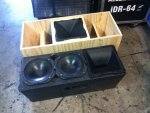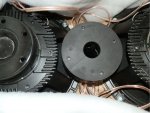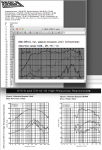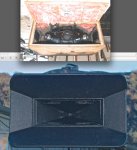Re: New DIY Mid High
Thanks again Simon,
Being located in Australia I don’t get to see all the equipment you have in Europe – I mainly see D&B, L-Acoustic, Meyer, EAW, Turbo, Martin, EV and JBL.
I must say the T24N at 33Kgs and a peak SPL of 143dB looks interesting. I considered building a box similar to T24, but the longer DIY horn gives you a bit more SPL in the 100Hz to 250Hz range.
The BMS 4594HE also has an advantage when compared to other compression drivers, it goes lower and louder than most and the 2 way design mean more pristine VHF without diaphragm breakup issues that you get with typical large format compression drivers . (see my time domain plots in the above post)
Below is a rough Hornresp sim of my best guess of the T24 compared to the DIY mid/hi. I tried it with a couple of drivers, the T24 seemed to like a driver with a heaver cone. The top plot is with 2 x RCF 12N405 (1000w) and the bottom with 12N351 (650w). The plots are at maximum power. The DIY uses the 12N351 to minimise the weight - 3.3Kg saving per driver.
As you can see the DIY has a 2 – 3 dB advantage in the low-mid according to the sim … but that of course is not the real world.
I have also included a picture of the partly constructed DIY and one of my earlier designs - it uses 2 x 10" and the same HF horn with a 4594 and passive crossover.
Hey Peter,
Seeburg is about an hour East of my old home in Stuttgart, Germany. They and another local company, TW Audio, had significant presence in the central European market and are both well respected. TW Audio is a bit more mainstream in their products, nothing really interesting or odd, but very good stuff and very well thought out. Seeburg is a bit more creative and as you noted, has some interesting products. Their mini line array cabinet is really hard to beat for Voice reproduction in reverberant spaces. I often rented one of their large horn loaded systems for outdoor concerts and always liked how smooth they were.
That being said, the TW Audio T24 is my absolute favorite cabinet so far. It's sound is incredibly coherent - the tonal balance doesn't change at all with distance, it just gets quieter. Two flown, one under the other, along with 4 of their double-15 subs a side is a hugely capable rig that fits easily in a 5x8 trailer. A few years ago I listened to them at ProLight and Sound in Frankfurt and thought they were doing a better job then even some of the high dollar line arrays.
Have you worked with the Powersoft amp modules? They look really promising, but I haven't seen pricing yet. If it's anything like the rest of the Powersoft line, they are going to be pricey.
Ciao
Simon
Thanks again Simon,
Being located in Australia I don’t get to see all the equipment you have in Europe – I mainly see D&B, L-Acoustic, Meyer, EAW, Turbo, Martin, EV and JBL.
I must say the T24N at 33Kgs and a peak SPL of 143dB looks interesting. I considered building a box similar to T24, but the longer DIY horn gives you a bit more SPL in the 100Hz to 250Hz range.
The BMS 4594HE also has an advantage when compared to other compression drivers, it goes lower and louder than most and the 2 way design mean more pristine VHF without diaphragm breakup issues that you get with typical large format compression drivers . (see my time domain plots in the above post)
Below is a rough Hornresp sim of my best guess of the T24 compared to the DIY mid/hi. I tried it with a couple of drivers, the T24 seemed to like a driver with a heaver cone. The top plot is with 2 x RCF 12N405 (1000w) and the bottom with 12N351 (650w). The plots are at maximum power. The DIY uses the 12N351 to minimise the weight - 3.3Kg saving per driver.
As you can see the DIY has a 2 – 3 dB advantage in the low-mid according to the sim … but that of course is not the real world.
I have also included a picture of the partly constructed DIY and one of my earlier designs - it uses 2 x 10" and the same HF horn with a 4594 and passive crossover.
Attachments
Last edited:






